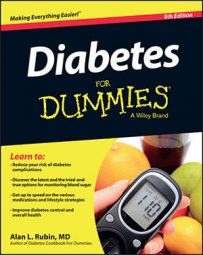Excluding vegetable sources of protein like soybeans, legumes, nuts, and seeds, protein in your diabetes-friendly diet is usually the muscle of other animals, such as chicken, turkey, beef, or lamb. For this reason, people used to believe that you could build your own muscle by eating lots of another animal's muscle. (The truth is that you can build up your muscle only by exercising or weightlifting.) You need little protein to maintain your current level of muscle (or to increase it, for that matter).
Your choice of protein is very important because some is very high in fat and some is practically fat-free. The following lists can give you an idea of the fat content of various sources of protein.
Very lean: One ounce of very lean meat, fish, or substitutes has about 7 grams of protein and 1 gram of fat. Examples include
Skinless white-meat chicken or turkey
Flounder, halibut, or tuna canned in water
Lobster, shrimp, or clams
Fat-free cheese
Lean: An ounce of lean meat, fish, or substitutes has about 7 grams of protein and 3 grams of fat. Examples include
Lean beef, lean pork, lean lamb, or lean veal
Dark-meat chicken without skin or white-meat chicken with skin
Sardines, salmon, or tuna canned in oil
Other meats or cheeses with 3 grams of fat per ounce
Medium-fat: An ounce of medium-fat meat, fish, or substitutes has about 7 grams of protein and 5 grams of fat. Examples include
Most beef products
Regular pork, lamb, or veal
Dark-meat chicken with skin or fried chicken
Fried fish
Cheeses with 5 grams of fat per ounce, such as feta and mozzarella
High fat: High-fat meat, fish, or substitutes contain about 8 grams of fat and 7 grams of protein per ounce. Examples include
Pork spareribs or pork sausage
Bacon
Processed sandwich meats
Regular cheeses like cheddar or Monterey Jack
Based on the fat, you can guess that low-fat and high-fat proteins have a huge difference in kcalories. An ounce of skinless white-meat chicken contains about 40 kcalories, whereas an ounce of pork spareribs has 100 kcalories. Because most people eat a minimum of four ounces of meat at a meal, they're eating from 160 to 400 kcalories depending on the source.
Many authorities suggest less protein in the diet because protein has a damaging effect on the kidneys. Several studies have shown this to be the case, but a very large study in the Annals of Internal Medicine in March 2003 came to a different conclusion. It showed that high-protein diets caused increasing damage in kidneys that already had some damage but not in normal kidneys. The jury remains out on this question of lower versus higher protein diets.

